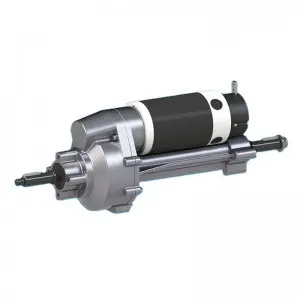The transaxle is an important part of any vehicle, responsible for transferring power from the engine to the wheels. It combines the functions of the transmission, axle and differential to provide seamless power transfer, ultimately improving the vehicle’s overall performance. But what if the rear transaxle is installed incorrectly? In this blog, we’ll explore the potential consequences and why ensuring rear transaxle compatibility is critical.
Learn about transaxles:
Before we dive in, it’s crucial to understand the role of the transaxle. A transaxle is a combination of transmission and differential located in one housing. In most cases, it is integrated into the engine itself or placed at the rear or front of the vehicle, depending on the drivetrain configuration (front-wheel drive, rear-wheel drive, or all-wheel drive).
Effects of incorrect installation of transaxle:
1. Performance compromise:
Installing an incompatible rear transaxle can have a serious impact on your vehicle’s performance. It can cause a significant loss of power, resulting in reduced acceleration, slower top speed and an overall decrease in fuel efficiency. Additionally, the wrong transaxle can affect the vehicle’s handling, resulting in an unstable and unresponsive driving experience.
2. Mechanical stress and damage:
Operating the transaxle beyond its design limits due to incompatibilities may create mechanical stresses that can lead to premature wear. Components such as gears, bearings and shafts can be subjected to excessive forces, resulting in expensive repairs. Additionally, the wrong transaxle can cause an imbalance in the driveline, which can lead to damage to other connecting components, such as the transmission or differential.
3. Safety hazards:
Perhaps the most concerning aspect of an improperly installed rear transaxle is its impact on safety. A transaxle that does not conform to the vehicle’s specifications may affect the vehicle’s braking performance, stability control system, and overall handling. This can jeopardize your safety and that of others on the road, increasing the risk of accidents and injuries.
Importance of compatibility:
To avoid the potential disaster described above, rear transaxle compatibility must be ensured. Here are a few key factors to consider:
1. Vehicle specifications:
Each vehicle’s transaxle has unique specifications. Factors such as engine power, torque, weight and drivetrain configuration play a vital role in determining the vehicle’s right rear transaxle.
2. Manufacturer’s recommendations:
When selecting a rear transaxle, be sure to refer to the manufacturer’s recommendations and guidelines. They provide essential information on compatibility and ensure you select the correct transaxle for your vehicle.
3. Professional assistance:
If in doubt, consult an expert or qualified mechanic. They have the knowledge and experience necessary to guide you through the process of selecting the right rear transaxle, ensuring your vehicle’s safety and optimal performance.
Installing the wrong rear transaxle can have disastrous consequences for your vehicle. It can negatively affect performance, cause mechanical stress and damage, and compromise safety. Therefore, it is crucial to know the specifications of your vehicle and choose the right rear transaxle accordingly. By prioritizing compatibility and seeking professional help, you can avoid potential pitfalls and ensure a smooth, trouble-free driving experience.
Post time: Sep-18-2023


